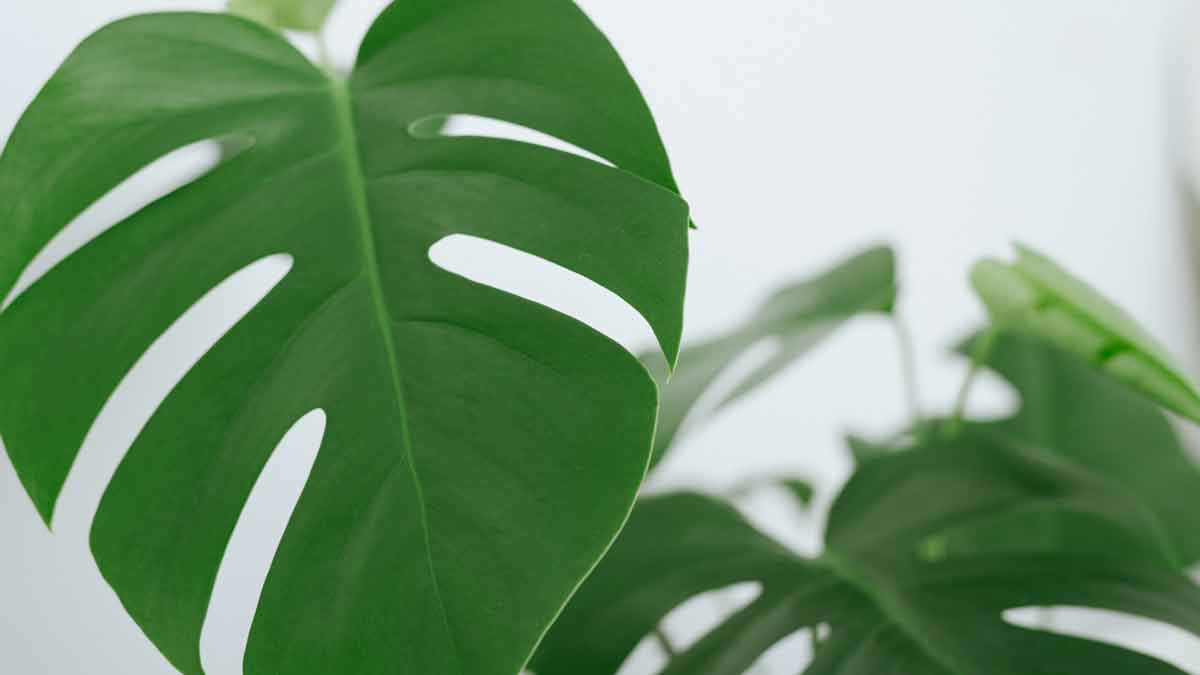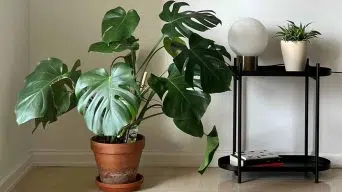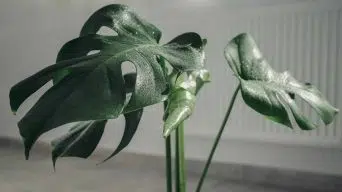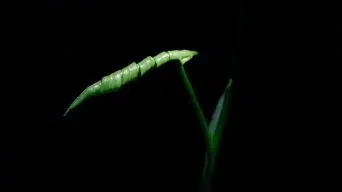To care for Monstera leaves, provide bright, indirect sunlight, regular watering (1-2 weeks, let the soil dry out), and adequate humidity. Clean leaves, inspect for pests, avoid overwatering (let the soil dry out), and direct sunlight. Fertilize and use appropriate soil (peat-based, well-drained).
Monstera plants are among the most popular houseplant choices due to their large, beautiful leaves and easy care requirements.
While caring for Monstera leaves is relatively simple, it’s important to follow certain steps to keep them healthy and vibrant.
Here we’ll explore some tips to help you ensure your Monstera leaves stay lush and green all year round.
From proper watering techniques to fertilizer application, these tips will give you the knowledge necessary for optimal growth and a thriving plant.
Understanding Monstera Leaves
Monstera plants are a unique species with a variety of different varieties, such as the Monstera Deliciosa or the Monstera Adansonii, each having their own distinct characteristics.
This makes them an interesting and attractive addition to any home or garden. Their thriving nature also makes them a popular choice for many gardeners.
Their distinct appearance sets them apart from other plants, featuring large, glossy leaves and intricate hole patterns.
However, there is much more to these plants than meets the eye.
Anatomy of the Monstera Leaf
Monstera leaves are easily recognizable by their large, glossy, and deeply-lobed features, showcasing unique fenestrations —patterns of holes or “windows” typically measuring around 20-30 cm (8-12 inches) in size.
These natural windows in the leaf’s structure allow the sun’s rays to permeate through it, enhancing light absorption for photosynthesis and aiding the plant’s thriving in the sun’s warmth.
In addition to these distinct features, the veins on the leaves stand out prominently, coursing along the length of the leaf in a crisscross pattern.
The underside of leaves tends to be lighter in color compared to the top side, facilitating better light absorption for photosynthesis.
Furthermore, the edges of the leaves often display serrations or waviness, imparting a unique and textured appearance.
Importance of Leaves
Leaves play an important role in plant growth and health.
They are responsible for photosynthesis, which is the process by which plants convert sunlight into energy for growth and development. The plant then uses this energy to produce food through respiration.
Additionally, leaves help regulate temperature and protect plants from pests and diseases by providing a barrier between them and their environment.
Leaves also provide shade for other parts of the plant, such as flowers or fruits, helping to keep them cool during hot summer days.
Finally, they help conserve water by reducing evaporation from soil surfaces through transpiration – releasing water vapor into the atmosphere through tiny pores on their surface called stomata.
The leaves of your Monstera are remarkable creations that offer beauty inside and outside our homes!
Not only do they look stunning, but they also play an essential role in helping plants grow healthy and strong.
Common Problems That Affect Monstera Leaves
Monstera plants are easy to care for but can be prone to certain problems.
Knowing what to look out for and how to address these issues is essential for keeping your Swiss cheese plant healthy and happy.
The most common problems Monstera leaves face are:
1. Yellowing Leaves
The primary concern commonly observed in almost all indoor plants, not just Monsteras, is the yellowing of leaves. The first reason for yellowing Monstera leaves is overwatering.
Giving your Monstera plant too much water can cause root rot, leading to yellowing leaves.
To prevent this, ensure you only water your plant when the soil is dry and avoid leaving it sitting in standing water.
2. Brown Spots
Brown spots on Monstera leaves can be caused by various reasons, such as overwatering, high humidity, exposure to direct sunlight, and mineral deficiencies.
To prevent brown spots from appearing on your plant’s leaves, make sure you’re watering it correctly and providing it with adequate light and humidity levels.
You should also ensure that the soil has enough nutrients by fertilizing it regularly.
3. Rust Spots
Rust stains on leaves may be caused by poor air circulation or too much fertilizer applied to the soil.
To prevent rust spots from appearing on your Monstera’s leaves, make sure you provide adequate air circulation around the plant and don’t overfertilize it.
Additionally, if you notice any rust spots already present on your plant’s leaves, remove them immediately with a damp cloth or cotton swab dipped in rubbing alcohol or diluted bleach solution.
4. Drooping Leaves
Drooping leaves are another common problem with Monsteras that can be caused by several factors, such as underwatering or too much direct sunlight exposure.
To prevent drooping leaves from occurring on your plant’s foliage, ensure you provide enough water (but not too much) and avoid placing it in direct sunlight for extended periods.
Additionally, if you notice any drooping leaves already present on your plant’s foliage, try misting them with a spray bottle filled with lukewarm water to help revive them back to their original shape and size.
Tips for Caring for the Leaves of Your Monstera
Caring for your leaves can be daunting at first, but it’s not that difficult once you get the hang of it.
Here are some tips to help keep your Monstera looking its best:
1. Watering
One of the most important aspects of caring for your Monstera is understanding how to water it properly.
Monsteras prefer soil that is lightly moist at all times.
This means you should allow the top layer of soil to dry out between waterings, but not so much that the plant starts to wilt or droop.
To achieve this balance, it’s essential to understand the appropriate amount and frequency for watering your Monstera plant.
The amount of water you give your plants will depend on several factors, including the size of the pot, the type of soil, and the climate in which it is growing.
Generally speaking, most types of monstera plants need to be watered once a week to once every two weeks.
You’ll want to water until the soil is saturated, but not so much that there’s standing water in the pot or tray beneath it.
Determining exactly when your Monstera needs watering can be challenging as each plant is different and may require more or less frequent watering depending on its environment.
A good rule of thumb is to check the top half inch of soil for moisture before watering; if it feels dry, it’s time for a drink!
It’s important not to overwater your plants, as this can lead to root rot and other issues, such as yellowing leaves or stunted growth.
If you notice any signs that your plant may be overwatered (such as soggy soil or wilting leaves), reduce the amount of water you give it.
Make sure there are drainage holes in the bottom of the pot so excess water can escape easily.
2. Lighting
Monsteras are tropical plants, meaning they need bright, indirect sunlight to thrive.
Direct sunlight can cause leaf burn, so ensuring your Swiss cheese plant is not exposed to too much of it is vital.
When it comes to lighting, the best way to ensure that your Monstera gets enough light without getting burned is by providing it with bright, indirect light.
This means placing the plant near a window where it will get some natural light but not be directly exposed to the sun’s rays.
You can also use artificial lighting, such as fluorescent or LED lights if you don’t have access to natural light.
If you choose to use artificial lighting, make sure that you keep the lights at least 6 inches away from the plant and turn them off at night. This will help prevent your Monstera from getting too much light and burning its leaves.
Additionally, try not to go over 60°F when it comes to the temperature of your lighting setup; Monsteras prefer temperatures between 65°F-85°F.
3. Humidity and Temperature
Monsteras, also known as Swiss cheese plants, are tropical plants that thrive in high humidity and temperatures between 60–80°F.
To keep your Monstera healthy, it’s important to understand the importance of maintaining a certain humidity level in the air around it.
Humidity is the amount of water vapor present in the air. It can be measured with a hygrometer, which will tell you what percentage of humidity is in the air.
Generally speaking, Monsteras prefer an environment with 60-80% humidity.
If your home doesn’t naturally have enough humidity for your Monstera to thrive, you can do a few things to increase it.
First, mist your plant regularly with a spray bottle filled with water. This will help add moisture to the air around your plant and keep its leaves hydrated.
You can also use a humidifier or place a water bowl near your plant (but not too close). This will help create more moisture in the air and make sure your Monstera stays happy and healthy!
Temperature is also an important factor when it comes to caring for Monsteras.
They prefer temperatures between 65°F-85°F (18-29°C).
If you live in an area where temperatures drop below this range during winter, consider moving your plant indoors or into a heated greenhouse to protect you from cold weather.
Additionally, make sure that direct sunlight isn’t hitting your plant too much, as this can cause leaf burn or scorching on its leaves.
4. Pruning and Maintaining The Leaves
Pruning and maintaining monstera leaves is important to keeping your plant healthy.
Proper Monstera pruning encourages growth, improves air circulation, and helps the plant to absorb more light.
It also helps to keep your Swiss cheese plant looking its best by removing dead or damaged leaves.
Here are some tips for trimming and caring for damaged or diseased leaves.
1.- Wear Gloves
When pruning your Monstera, it’s important to wear gloves to protect yourself from any sharp edges on the leaves.
This will also help to prevent any potential infection from spreading between plants.
2.- Use a Sharp, Clean Tool
Using a sharp tool is essential when pruning the leaves as it will ensure you get a clean cut and won’t damage the stem or node of the leaf.
Make sure that you use a clean tool so that you don’t spread any disease between plants.
3.- Prune in Spring
Try to prune your Monstera in the spring, as this is when new growth begins, and the plant has more resources available for healing.
Pruning at this time will also help to encourage new growth throughout the year.
4.- Plan Your Cuts
Before you start pruning your plant, take some time to plan out where you want to make cuts so that you don’t over-prune or leave too much stem behind on each leaf.
When making cuts, you should aim for about 30% of the plant’s total volume to avoid becoming too top-heavy or unbalanced.
5.- Remove Dead Leaves Regularly
Removing dead or dying leaves all year round is important, as this will help keep your plant healthy and encourage new growth.
If there are large areas of dead or damaged leaves, it may be best to wait until spring before attempting any major pruning.
This will give the plant more resources for healing after being trimmed back.
6.- Cut Below Nodes
When making cuts, make sure that they are made below nodes (the small bumps along stems) so that new shoots can grow from them later on down the line.
This will help ensure that your Monstera plant stays full and lush even after being trimmed back significantly.
7.- Don’t Overwater After Pruning
After pruning your Monstera, it’s important not to overwater it as this can cause root rot, killing off entire sections of the plant if left unchecked.
Ensure you only water when necessary and always check soil moisture levels before adding more water.
8.- Monitor New Growth Closely
Once you have finished pruning your Monstera, monitor its new growth closely over the next few weeks or months so that you can catch any potential issues early on before they become too serious.
Pay particular attention to any discolored or wilted leaves, as these could indicate an underlying issue with either pests or diseases that need addressing quickly for them not to spread further throughout the Monstera foliage.
5. Fertilize Monstera Plants for Healthy Leaf Growth
To keep your Monstera plant looking its best, it’s important to fertilize it regularly with the right type of fertilizer.
The best fertilizer for Monsteras has an NPK ratio of 3-1-2 (nitrogen-phosphorus-potassium). This ratio gives the plant all the key nutrients it needs to stay healthy.
You should feed your Monstera once a month during the growing season (April through September) with a 1/4 diluted houseplant fertilizer.
Apply directly to the soil base so the roots can quickly absorb the nutrients.
You can also use a liquid fertilizer every two weeks during these months.
Ensure not to overfertilize, as this can cause damage to your plant’s leaves.
6. Pest Control
While they are relatively easy to care for, they can be susceptible to pests and diseases.
The most common pests affecting monstera plants include mealybugs, aphids, spider mites, scale insects, thrips, and whiteflies.
Mealybugs are small insects covered in a white waxy coating. They feed on the sap of the plant and cause yellow leaves.
Aphids are tiny green or black insects that suck the sap from the plant’s stems and leaves.
Spider mites are tiny red or black arachnids that spin webs around the plant’s foliage.
Scale insects look like small bumps on the stems and leaves of the plant and feed on its sap.
Thrips are tiny black bugs that suck out the juices from the leaves and flowers of plants.
Whiteflies are small white flying insects that feed on the sap of plants and can cause yellow foliage.
How To Prevent Pest Infestations
Properly keeping your plant healthy is the best way to prevent pest infestations on monstera leaves.
Ensure you water your plants regularly, but not too much; overwatering can lead to root rot attracting pests such as mealybugs and aphids.
Keep your plant in an area with good air circulation to discourage pests from settling in; stagnant air traps moisture, creating an ideal environment for them to thrive in.
Regularly inspect your plant for signs of pests such as webbing or discolored patches on its foliage; if you spot any signs of infestation, take action immediately before it spreads further throughout your plant.
Treating Pest Infestations
If you do find yourself dealing with a pest infestation on your Monstera leaves, there are several methods you can use to get rid of them:
- Insecticidal soap: Insecticidal soap is a natural, safe alternative to chemical pesticides. It works by covering the bodies of pests in an oily film that suffocates and kills them on contact.
- Neem oil: Neem oil is a natural plant-based pesticide made from the seeds of the neem tree. It disrupts pests’ reproductive cycle, making them unable to lay eggs and reproduce.
- Isopropyl alcohol: Isopropyl alcohol is a strong disinfectant that can kill pests on contact. It is safe to use on plants, but be careful not to get it into the soil as it can damage roots and prevent growth.
- Horticultural oils: Horticultural oils are plant-based oils that smother pests on contact. They are safe to use around plants and have the added benefit of conditioning the foliage and killing pests.
- Biological controls: Biological controls such as ladybugs and predatory mites are natural predators of pests, making them a safe and effective way to get rid of infestations
By following these simple steps, you should be able to keep your Swiss cheese plant free from pesky pests while still enjoying its beautiful foliage!
7. Use a Moss Pole or Trellis to Support Leaf Growth
Supporting your Monstera’s leaf growth is crucial for a healthy and aesthetically pleasing plant. Using a moss pole or trellis can help the plant climb and produce larger, more vibrant leaves.
- Select a Sturdy Support: Choose a moss pole or trellis that is tall enough to support the eventual height of your Monstera. Ensure it is strong and stable enough to handle the weight and growth of the plant.
- Secure the Plant: Gently guide the Monstera’s aerial roots towards the pole or trellis, assisting them in attaching and climbing. Soft ties, plant clips, or twist ties can be used to secure the stems in place without causing damage.
- Monitor Growth: Regularly check your Monstera’s growth and adjust the ties or support as necessary. As the plant grows, reposition the ties to ensure it continues to climb securely and in the desired direction.
- Prune and Shape: Trim any unwanted or damaged leaves to encourage new growth and maintain an attractive shape. Removing excess foliage allows the plant to concentrate its energy on producing larger, healthier leaves.
- Provide Adequate Water: Ensure that the moss pole or trellis remains consistently moist to promote healthy root growth and aid the Monstera in climbing. Regularly check the moisture level and adjust watering as needed.
- Maintain Humidity Levels: Monstera plants thrive in a humid environment. If the air in your home is dry, consider using a humidifier or placing a shallow water tray near the plant to maintain adequate humidity levels.
By following these tips, you can support healthy leaf growth and ensure your Monstera thrives while enhancing the aesthetics of your home.
8. Leaf Cleaning
Regularly cleaning your Monstera leaves is essential for keeping them healthy and looking their best.
Dust, dirt, and other debris can accumulate on the leaves over time, blocking light and air circulation, both essential for photosynthesis.
This can cause the plant to become weak or even die if not addressed quickly.
Dust can also attract pests such as aphids or mealybugs, which can cause further damage to the Swiss Cheese plant if left untreated.
How To Clean Monstera Leaves Without Damaging Them
Cleaning plant leaves doesn’t have to be complicated or damaging!
Here are some tips on how to do it without harming your beloved houseplant:
- Use a soft cloth or brush – Using a soft cloth or brush is one of the best ways to clean the leaves without damaging them. Make sure you use something that won’t scratch or tear at the delicate foliage. A damp cloth works well, but make sure it isn’t too wet, as this could cause water damage to the plant.
- Gently wipe away dirt – Once you have your cloth ready, gently wipe away any dirt or debris from the surface of each leaf with gentle strokes in one direction only (not back and forth). This will help prevent scratches or tears while removing all unwanted particles from each leaf’s surface.
- Rinse with lukewarm water – After wiping down each Monstera leaf with a damp cloth, rinse them off with lukewarm water using either a spray bottle or submerging them in a bowl filled with lukewarm water for about five minutes before patting dry with a soft towel afterward. This will help remove any remaining dirt that may have been missed during the wiping down process and give your Monstera an extra boost of hydration!
- Avoid direct sunlight – Finally, make sure you avoid exposing the leaves to direct sunlight after cleaning them, as this could cause sunburns which would be very damaging to your plant’s health!
With these simple steps, you can keep your leaves clean without causing any damage!
Regularly cleaning your leaves will help keep them healthy and looking their best, so remember to add it to your regular houseplant care routine!
Final Thoughts
Learning how to care for Monstera leaves is essential for enjoying the beauty and longevity of your plant.
With some basic knowledge, a bit of effort, and a little patience, you can enjoy thriving plant leaves that will bring lasting joy to your home or office.
Monitor your Monstera’s watering, light, humidity, temperature, and soil quality to ensure optimal growth and longevity.
You can keep your Monstera leaves beautiful for years with proper care and attention!







